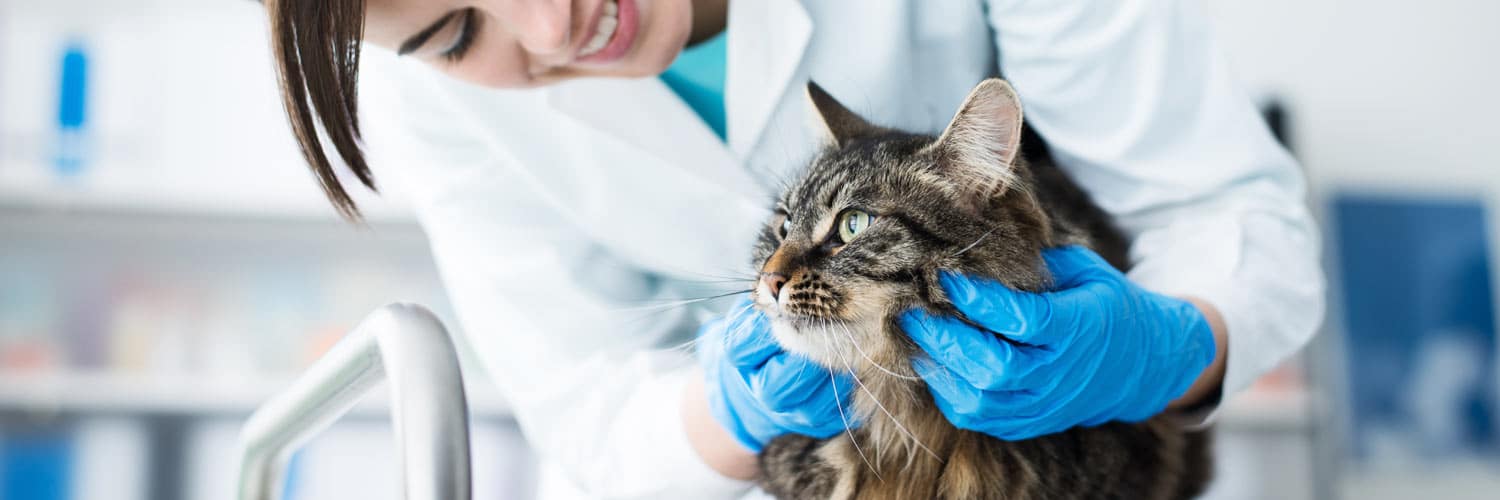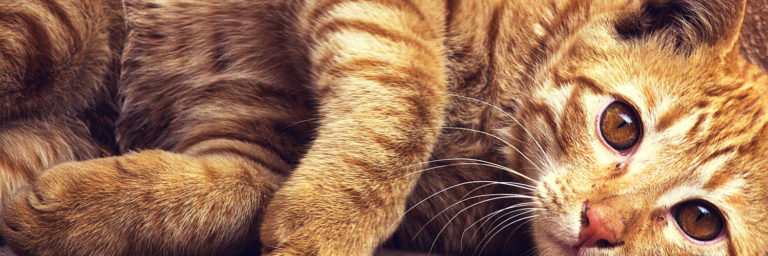The Best Cat Insurance Providers : Finding Peace of Mind
Contents of Article
Last updated January 13, 2023
A sick or injured cat is stressful enough.
The cost of unexpected veterinary bills can be a huge financial blow. An accident or illness could quickly rack up bills in the thousands of dollars, leaving cat guardians to make decisions that no one should have to make.
Veterinary insurance can offer some peace of mind for those concerned about catastrophic medical costs. If you’re someone who takes your cat in for regular wellness visits or gets them checked out at the first whisper of behavioral change, a wellness plan can help to cover some of those regular costs.
The first pet insurance policy in North America was sold in 1982 by Veterinary Pet Insurance, a subsidiary of Nationwide, and it didn’t cover any ordinary dog – the policy was for a dog portraying the TV character Lassie. Since then, pet insurance has seen rapid growth in the United States – but it is still a hotly-debated investment that’s yet to gain widespread popularity.
What is the Best Cat Insurance?
Is cat insurance really worth it?
Just about 1% of all pets in the United States are covered – and 91% of those pets are dogs.
Policies are not standardized and it can be an exhausting brain-twister to find the one that is right for your pet. When choosing a cat insurance policy, the number one consideration is usually price – and lower premiums usually means serious compromise in other parts of the policy. Premiums vary based on your cat’s unique needs – purebred cats, like Persians, will face higher premiums based on the fact that they’re prone to hereditary conditions. Some plans don’t cover hereditary conditions at all. Almost all cat insurance providers refuse to cover pre-existing conditions.
Obviously, cat insurance is still unpopular in the United States. Many recommend creating a personal emergency savings fund instead; this can be a prudent alternative for some cats and households.
Is your cat a good fit for health insurance?
There are countless variables that affect whether or not cat insurance will be worth it for you.
By taking economically-motivated euthanasia off of the table, insurance delivers peace of mind for those who know that they can’t easily pay the bill for expensive medical treatments. If your main concern is wellness coverage for routine veterinary visits, it’s important to do the math and figure out if an insurance policy is worth it.
It’s best to take out an insurance policy when your cat is young, as kittens can get better rates than older cats.
If you have an older cat whose veterinary expenses are primarily due to existing chronic conditions, health insurance is probably not right for them. Most pet insurance providers don’t cover pre-existing conditions and insurance premiums typically start higher for older cats.
It’s always a good idea to check with your veterinarian to ensure that they work with the insurance provider you’re considering. Your veterinarian can also offer advice in terms of which insurance would work the best for your cat.
Choosing the Best Cat Insurance
Again, the right policy depends on a combination of factors that is unique to you and your cat. Let’s get you started by breaking down the essentials.
What type of plan is best for your cat?
Accident
Accident-only coverage won’t cover health issues such as kidney disease, cancer, allergies, diabetes, or other illnesses, nor will it cover any routine veterinary visits. This lower-cost policy type only covers accidents like snake bites, poisoning, swallowed objects, and injuries. If you have an older cat with pre-existing conditions that wouldn’t be covered by an illness or wellness plan, an accident plan may be a good choice for you. That said, it doesn’t generally deliver the greatest value. According to research by VPI in 2013, the five most common accidents among cats were:
- Soft-tissue trauma
- Lacerations or bite wounds
- Scratches or wounds on the eye
- Mouth and tooth trauma
- Abrasions
While some accidents may lead to huge bills, in 2013, the average claim amount for each of the above issues didn’t exceed $250 – a cost that could easily be covered by an emergency fund.
Illness
These plans may be more expensive than accident-only coverage, but illness plans typically include accident coverage, making them ultimately a better value. While coverage varies from policy to policy, these plans typically cover common illnesses that your cat might deal with. Conditions covered by most policies include cancer, diabetes, arthritis, allergies, infections, and epilepsy. Not all illness policies, however, cover hereditary conditions and most won’t cover any pre-existing conditions.
Wellness
Wellness plans cover your regular medical expenses. Depending on the specific plan you choose, these plans may apply to dental cleanings, vaccinations, spaying and neutering, and annual examinations. Again, depending on your cat’s regular medical routine and your unique situation, this could be more or less a good value. Wellness plans are usually tacked on to or included as a part of a comprehensive coverage package.
The most popular type of pet insurance is a comprehensive package combining accident, illness, and wellness coverage.
Check for Common Exclusions
When seeking an insurance provider, bear in mind that certain conditions and treatments will be excluded.
Some of the most common are:
- Pre-existing conditions
- Non-veterinary expenses
- Treatment for parasites
- Herbal and holistic treatments
- Age limits
- Hereditary conditions
Specific exclusions will vary from company to company, but one is universal: pre-existing conditions are never covered.
That said, companies will define these conditions differently.
Some companies paint pre-existing conditions with a broad brush – stating that any issue that your cat has been treated for in the past – and any conditions connected to it – are ineligible for coverage, even after they’ve recovered.
Because the stringency of this exclusion isn’t something that the provider will volunteer, customer reviews are your best resource for learning about the company’s reputation.
Remember that many insurance providers have a waiting period after you purchase the coverage. For example, you might have to wait fourteen days before making your first claim. Any treatments during that waiting period won’t be covered.
Reimbursements and Deductibles
When choosing a cat insurance provider, it’s important to know how all payments and payouts work.
The insurance company will either be billed directly or will deliver a reimbursement after you’ve already paid upfront. In the latter case, check reviews to make sure that the company is known for a quick turnaround time and reliable payments.
Sometimes the reimbursement percentage is for the actual treatment your cat receives, but in other cases, the insurance company pays a percentage of the “standard” charge for that treatment. This predetermined amount may be more or less than what your vet actually charges.
A lower deductible and higher reimbursement rate correlates to a higher premium, and vice versa.
You’ll also want to consider benefit limits. Some insurance plans have annual limits, while others have unlimited lifetime benefits.
Customer Satisfaction
Of course, customer satisfaction is an important representation of the quality of a cat insurance provider. Take a look at customer reviews to find out how real customers feel about the company. If you spot a lot of reviews complaining about poor customer service, vague policy information, delayed reimbursement, and fluctuating premiums, it’s a good sign that this insurance company is not delivering a high-quality product.
Top 5 Best Cat Insurance Providers
Healthy Paws Pet Insurance Review
This insurance provider is set apart from the rest with its unlimited lifetime coverage – that means no annual benefit caps. The company offers comprehensive coverage for all accidents and illnesses, with no exclusions for hereditary conditions. In addition, it covers hospital stays, diagnostic treatment, alternative treatment, surgeries, and emergency care. It’s worth noting that its dental coverage is only for accidents and won’t cover other dental treatments.
However, Healthy Paws doesn’t offer wellness coverage. Additionally, no coverage is offered for elective treatment, behavioral therapy, or boarding.
You have your choice of deductible and reimbursement levels. The reimbursement is calculated from the actual cost of the veterinary treatment:
- Choice of deductible of $100 to $500
- Choice of reimbursement percentage – 70%, 80% and 90%
Healthy Paws comes with a variety of discounts, including those for for members of AARP, AAA, and Costco. Animal welfare volunteers and those in military service can also get lifetime discounts from this company.
Pros
- Covers all accidents and injuries without exclusions for hereditary conditions
- Unlimited lifetime coverage
- An attractive selection of discounts
Cons
- Doesn’t offer wellness coverage
- Doesn’t cover pre-existing conditions
- Cats older than 14 years can’t start a new policy
Learn more: https://www.healthypawspetinsurance.com/
Petplan Pet Insurance Review
With its truly comprehensive plans, PetPlan insurance eliminates the need to multiple add-ons for full coverage. In addition to accident and injury coverage, every plan from PetPlan includes alternative treatments, specialist treatments, veterinary examinations, diagnostic treatments, dental treatments, and prescription medications. Hereditary and congenital conditions are covered, while pre-existing conditions are excluded.
When you have annual vet coverage of over $15,000, you get additional benefits including the loss of your pet due to theft or straying, including the advertising and rewards associated with a lost cat, behavioral treatment, and boarding kennel fees.
PetPlan cat insurance is customizable, allowing you to select your choice of annual coverage (including unlimited coverage), deductible, and reimbursement percentage.
- Choice of annual coverage amount – $2500 to unlimited
- Choice of annual deductible amount – $100 to $1000
- You can choose your reimbursement percentage – 70%, 80%, or 90%
Pros
- Unlike many other providers, Petplan has no upper age limit for signing up
- Offers discounts to veterinary professionals
- All plans cover injuries and illnesses, including those due to hereditary conditions
- Offers highly comprehensive coverage
- Flexible pricing and payout
Cons
- Costs tend to increase dramatically as your cat ages
Learn more: https://www.gopetplan.com/
Embrace Pet Insurance Review
This pet insurance provider offers one comprehensive plan that covers “all of your pet’s unexpected accidents & illnesses”.
The policy is customizable, allowing you to choose your benefit limits, deductible, and rate of reimbursement:
- Your choice of deductible ranges from $200 and $1000.
- Embrace’s annual coverage limits are between $5,000 and $15,000.
- Choose a reimbursement percentage of 65%, 85%, or 90%.
In addition to the comprehensive accident and illness plan, Embrace offers a flexible wellness rewards program that works like a health savings account and covers routine expenses like spaying and neutering, vaccinations, nail clipping, grooming, and prescription food purchased at the vet. This program comes with three reimbursement options to suit different needs. If your cat isn’t eligible for comprehensive illness and accident coverage, the company also allows you to choose an accident-only plan.
Pros
- Covers hereditary conditions
- Choose your own deductibles
- Covers almost every necessary medical treatment
- Instead of offering a benefit schedule, reimbursements are based on actual vet bills
- Offers a $50 “Healthy Pet Deductible” benefit each year that you don’t make a claim
Cons
- Doesn’t cover pre-existing conditions and the company’s definition of these pre-existing conditions tends to be unusually broad
- Doesn’t cover cosmetic treatments
- Cats who are currently over the age of 14 are ineligible to sign up for a new policy
Learn more: https://www.embracepetinsurance.com/
Nationwide Pet Insurance Review
Nationwide offers a higher-priced insurance with a reputation for extraordinarily comprehensive coverage. That said, it’s not the most flexible option – you pay a single deductible annually and reimbursements are less customizable than those offered by other providers.
Nationwide Pet Insurance offers three different plans: Whole Pet with Wellness, Major Medical, and Pet Wellness.
Whole Pet with Wellness is an extraordinarily comprehensive plan that covers accidents and illnesses, hereditary conditions, chronic conditions, and wellness examinations and treatment. It comes with no benefit limits. Additionally, it reimburses 90% of all medical costs.
For a comprehensive illness and accident plan that doesn’t include wellness coverage, Major Medical is lower-priced and covers all major medical costs.
Their wellness plan covers all routine medical costs, like flea treatment and vaccinations.
While all of Nationwide’s plans are not limited by annual benefit caps, all but Whole Pet with Wellness are on a benefit schedule, so the benefits are limited for each condition and service. The deductible is an annual payment of $100-$500.
Pros
- The highest-level plan has exceptionally comprehensive coverage and unlimited benefits per condition and service
- No annual benefit caps
- Offers a low annual deductible
- A well-established and very stable company
Cons
- Cats over the age of 10 are not eligible for a new policy
- Less flexible than some other options available
- A higher-priced insurance
Learn more: https://www.petinsurance.com/
Pets Best Review
While its coverage isn’t the most comprehensive and the company has a reputation for broadly defining its exclusions, Pets Best stands out with its highly flexible pricing plans and coverage options.
This company offers three coverage plans: Essential, Plus, and Elite. All of these plans cover all accidents and injuries, plus emergency care and hereditary conditions. This includes cancer, chronic illness, accidental dental issues, and dental illness. Each plan also offers prescription coverage. The Plus and Elite plans cover examinations, rehabilitation, chiropractic therapy, acupuncture, and other therapy. You can also choose their accident-only policy.
While wellness benefits are not included in the three primary plans, Pets Best offers two different wellness plans that you can tack onto your main policy.
Like the other providers on the list, you have your choice of deductible and reimbursement percentage. The Essential and Plus plans have annual benefit caps, while the Elite plan offers unlimited coverage.
- Offers annual coverage limits of $5000, $10,000, and unlimited
- Choose a deductible of between $50 and $1,000
- Choose a reimbursement level of 70%, 80%, or 90%
With no upper age limit for signing up, Pets Best is a good choice for older cats.
Pros
- No upper age limit for signing up
- Highly flexible pricing
- Premiums can be exceptionally low, especially if you choose to go with the accident-only plan
- Multiple annual coverage options
- 24/7 customer service line
- 3 day average reimbursement time
Cons
- The company’s definition of pre-existing conditions tends to be unusually broad. Customers complain that they’ve been refused coverage for a condition that Pet’s Best unexpectedly deemed to be connected to a previous issue
Learn more: https://www.petsbest.com/








I would love to know why the Merrick cat food “Gourmet oven roasted chicken shreds” i am not available for purchase? What is going on is there a recall should I be worried because that is all I have fed my Siamese. She loves the food!!